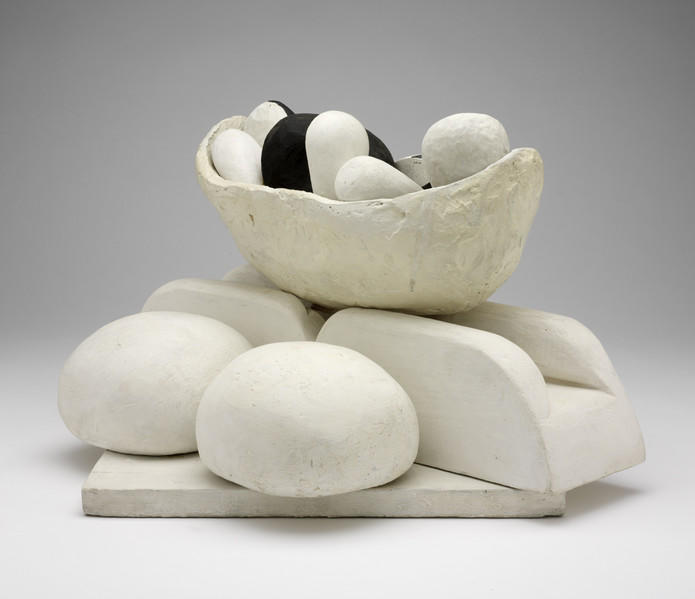As a curatorial intern for the Contemporary Art Department at the RISD Museum during the summer of 2016, I was introduced to the in-depth experience of museum work. One of many tasks given to me was rewriting the labels of selected art pieces. As excited as I was to write labels, the writing process was intimidating for many reasons. One reason was that I never had written labels before. With a limit of one hundred words, I was forced to condense my research and ideas into a brief summary. Given a writing guide, I focused on what felt to be the most important points in creating a successful label: tone, language, and content. Every written piece has a central theme; one of the important themes is the tone. Tone can be formal or informal. When writing a label for the museum, the writer uses a somewhat formal tone; however, the writing must also encourage viewers to understand and be interested in what is in front of them.
Language relates to the important skills of organization, sentence structure, and vocabulary. When the viewer sees an art piece, they often first pay attention to the detail, making description on the label important. Describing the art piece, the writer must use vocabulary that is not too elaborate, but instead relatable to the entire audience. Organizing the label, the writer must take into consideration what the audience is thinking about when seeing an object so that the label can grab their attention. Lastly, the content focuses on what the writer is trying to convey. They must research before writing the label, connecting the writer’s interpretation with other factual information. These topics were a challenge for me, because as an artist, I am accustomed to speaking to other artists, not taking into account that our dialogue can be confusing to someone with no artistic background. After I began writing, I began to understand how a label should be written. However, that understanding was entirely different than limiting my research to a brief summarization.
Drawn to Still Life, a work by surrealist and feminist artist Louise Bourgeois, I became more interested in her life and how it reflected in her work. I began write about Bourgeois’s life instead of the actual piece. I began to write about different subjects, such as physicality, sexuality, and technique. Limited by a word count, I did not have enough space to express Bourgeois’s entire life and all her experiences. I shortened the label to focus solely on the piece and how it relates to the artist’s identity.
Looking at the final label for Still Life, I am glad to have made these changes, because now it focuses on the piece and the artist. As an artist, I use language that may be different than that of the viewer, and the experience of writing labels was enough for me to learn to use different language depending on the individual. Exiting from my comfort zone and entering a new form of communication is fascinating and important for someone like myself who wants to be more involved in the curatorial field in the future. After this experience, I am more comfortable with and aware of my approach to my writing.
Labels: These draft labels reveal my writing process, and what was taken into consideration as I worked to create a final label.
Draft 1: Physical Form
Participating with the rise of surrealism, feminism, and abstract expressionism, artist Louise Bourgeois had spent her artistic career creating narrative sculptures of her experiences as a woman, daughter, wife, and mother. Bourgeois repeatedly uses sexuality as a theme to exposes her insecurities and fragility to the viewer. However, in Bourgeois’s Still Life the soft texture, round elements, and monochromatic palette would still continuously refer to her interest with sexualizing and reconstructing the human condition and physical form. Bourgeois’s art work is represented in collections of major museums around the world. Louise Bourgeois is known to be one of the most influential artists of the twenty-first century.
Draft 2: Technique
Still Life is presented as a simple study of a bowl of fruit with two loaves of bread; however, surrealist and feminist artist Louise Bourgeois uses a raw process to create organic and geometric objects that contrast between the delicate and strong structures of both the food and bowl. Developing her own primitivistic style, she embraced the varied techniques to construct material into a three-dimensional piece to speak about the individual content. Bourgeois explored the physical work of sculpture to openly express her frustration, sadness, anxiety, and fear to the public to encourage them to focus on her internally.
Draft 3: Gender Roles within Sexuality
Surrealist and feminist artist Louise Bourgeois approached her work with a personal thematic content. Examining the physical forms, both sexual and therapeutic, Bourgeois abstracted the male and female genitalia, exposing her negative childhood experiences of confusion and betrayal. With simplified shapes to suggest organic forms, Still Lifepresents as a bowl of fruit accompanied by two loaves of bread. The rough texture of the bowl represents masculinity, while the soft yet round biomorphic objects are associated with the femininity. As the feminine objects are in the bowl, it represents the artist views of women being contained by men in a gender-role society.
Lilibeth Leon (Rhode Island College, BA 2016, Painting) was an Andrew W. Mellon Summer Intern at the RISD Museum in 2016.
